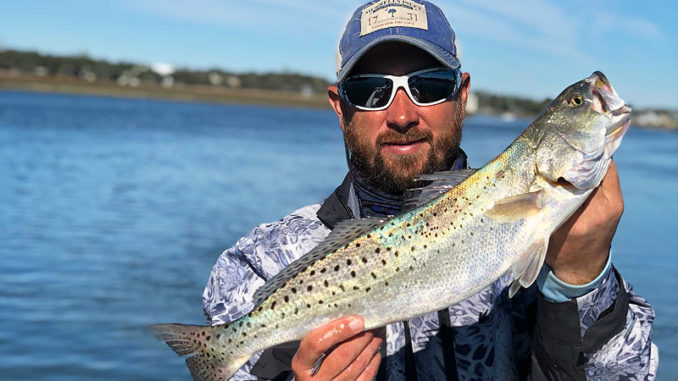
Mild winter means good bite for spring specks
The Carolinas’ weather can be very indecisive at times, and that couldn’t be any more true than in March. For anglers, it is the tail end of winter and the beginning of spring, with many warm days on the horizon. For anglers targeting speckled trout, Murrells Inlet, S.C., can be a good place to enjoy the day.
Dan Connolly of O-Fish-Al Expeditions said the past winter gave up the goods and is continuing to give his clients plenty of speckled treasures
“When we don’t have a harsh winter, we keep a pretty big population of trout in the Inlet,” said Connolly (843-241-7022). “We have some fish that migrate in during the fall and others that are year-around residents. As long as we keep some glass minnows, shrimp or other bait for them to eat, the trout will stay around.”
Early in spring, Connolly will camp out either at the jetties or just inside them in main creeks. Most of the available food will be near the ocean; that will keep trout and other predators nearby.
“Most baits are staying close to the ocean, and many of the bigger trout will be along the jetties unless we get warmer water early, and then the bait will slide into the creeks early, pulling some of the big fish with them,” he said.
Live bait is tough to beat
Trout will strike a wide variety of baits and lures throughout the year, but for Connolly, live bait under a slip cork is hard to beat.
“A slip float drifted in the current is my No. 1 technique because it is the most natural way to present baits,” he said. “I prefer live shrimp when you can get them, but I will use mud minnows or mullet if I can find any.”
Typically, specks will be found on or near the bottom. Water temperature is a driving factor, especially in March when temperatures can vary abruptly. Trout will work a large array of the water column to find the best water conditions and spots where food will most likely become available.
“I like to fish within 15 feet of the jetty rocks and towards the bottom end of the water column, but I often adjust my float accordingly depending on where I am fishing and how the fish are responding,” he said.
He will also fish inside the estuary, especially when a warm trend arrives. Trout will follow the baitfish in, and Connolly will target trout at the mouth of creeks, next to deep holes, and along the main creeks abundant with submerged oyster rakes.


